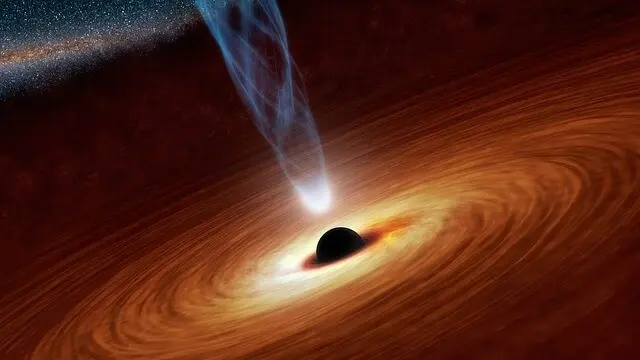
It is surprising to know that there are too many similarities between Lord Shiva and a black hole. Most of the symbols and many questions associated with Lord Shiva can be explained with this assumption. The stories in the Hindu scriptures are allegorical and have multiple meanings. Many scientific facts are hidden in them. Before seeing the similarities between Lord Shiva and a black hole, let us first see what a black hole is.
What is a Black Hole?
A black hole is a place in space where gravity is so strong that nothing can escape from it, including light. It is invisible to human eyes. When a black hole and a star are close, high-energy light is made. Scientists use satellites and telescopes in space to see that light. Also, some black holes emit X-rays in all directions. Telescopes measure the X-ray light, and scientists use this information to learn more about black holes. There are four types of black holes, viz. stellar, intermediate, supermassive, and miniature.
How is a Black Hole Formed?
When stars die (when there is no fuel to burn), most of them inflate, lose mass, and then cool to form white dwarfs. But the massive stars that are typically 10-20 times massive than our Sun either become neutron stars or stellar-mass black holes.
When a huge star explodes (supernova), it leaves behind the core. When the star is alive, nuclear fusions create constant outward push that balances the inward pull of gravity from its own mass but in the remnant of a supernova, there are no longer forces to oppose that gravity, so the star core begins to collapse in on itself. If its mass collapses into an infinitely small point, a black hole is born. A black hole continuously grows by absorbing gas and interstellar dust from its surroundings.
Similarities between Lord Shiva and a Black Hole:
Meaning of the Word Shiva:
In folk etymology, the roots of the word śiva are śī which means “in whom all things lie; pervasiveness” and “va” which means “embodiment of grace.” Therefore, Shiva means “an embodiment of grace that is all-pervasive.”
Why is Lord Shiva called the Destroyer?
We know that Lord Shiva destroys the whole universe, but we do not know how he does so. The Hindu scriptures say that he does so with the Tandava dance, which is metaphoric to creation, sustenance, and destruction of the universe but it sounds cryptic and is beyond understanding. Then, can there be a scientific reason behind why he is called the destroyer?
According to the Big Bang theory, the universe at the beginning was very hot and confined to a small point called the initial singularity. It is currently expanding, but there would be a point when it would stop doing so and start contracting and end in a singularity. That point would be a black hole that would consume everything. Therefore, we can say that a black hole is a symbol of destructive power.
This functionality of the universe is controlled by Lord Shiva, and therefore, he is called “the destroyer.”
Scriptural Evidence that links Lord Shiva to a Black Hole:
1. The Subala Upanishad (2:4) says that at the time of the dissolution of the manifested universe all matter merges into darkness before being reabsorbed into the Brahman. Likewise, the universe re-emerges from the darkness.
Linga Purana says Lord Shiva is the substratum of Brahman. Therefore, the darkness mentioned above symbolically represents Lord Shiva.
2. In the Skanda Purana, Lord Shiva says that the whole universe is born out of the linga and would ultimately dissolve into it. The same concept is mentioned in the other Puranas also.
What does this mean? It means that the linga symbolically represents a black hole, and the whole world was born out of it and would dissolve into it.
The Scientific Meaning of the Story of Lingodbhava:
In the story of Lingodbhava, it is mentioned that before creation, Lord Brahma and Lord Vishnu were quarreling over superiority. Then suddenly from nowhere, a column of fire appears in between them, and Lord Shiva and the goddess Uma come out of it. Lord Shiva tells them that they have forgotten that they are born out of him.
After reading this story, several questions come into mind. If there was nothing, then where were those gods standing, and where was that column of fire located? Why were gods fighting for superiority?
We can find the clues to solve this puzzle in the names and Hindu iconography.
In this story, Lord Brahma is symbolically represented as the universe (Brahmanda), Lord Vishnu as the matter [Vishwa (world) + Anu (atom)], Goddess Uma or Shakti as the energy, and Lord Shiva as a black hole!
The symbol of the lotus is of great significance in Hinduism. Lord Brahma is mostly depicted as sitting on an opened lotus flower coming out of the navel of Lord Vishnu. A lotus bud looks like Hiranyagarbha. A lotus has 18 petals, and 9 (1+8) is a sacred number in Hinduism.
Therefore, Brahma coming out of a lotus actually symbolizes Brahmanda, i.e., the universe.
Lord Brahma, born out of the lotus coming out of the navel of Lord Vishnu, symbolizes Brahmanda is made up of matter.
In this story, Lord Shiva is depicted as superior to Lord Vishnu and Lord Brahma, and Lord Shiva says that they were born out of him. He says so because matter and the whole universe were created (born) out of a black hole. The column of fire is the blast coming out of the exploded cosmic egg. As it was traveling at the speed of light, Lord Brahma and Lord Vishnu could not find its end. The AUM sound was produced at that moment. Therefore, the Shiva lingam represents the moment of creation.
In the Puranas, Lord Vishnu is also called the creator of the universe.
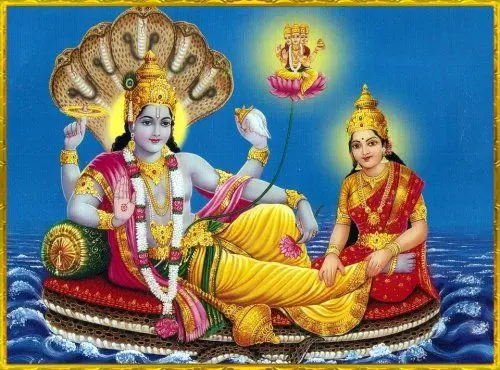
Image Credit: Srimadh Vyasa
The above photo also represents the moment of creation.
Both the Shiva lingam and the above image are inspired by the Vishwakarma Sukta (Rigveda 10.82.6) that says that the cosmic egg is placed on the navel of the Supreme Creator.
Similarities between the Three Forms of Lord Shiva and a Black Hole:
In Hindu iconography, Lord Shiva is typically depicted with three images.
1. Shiva lingam – represents the moment of creation of the universe.
2. Shiva meditating with his eyes half-opened – sustenance of the universe.
3. Nataraja – the destruction of the universe.
Lord Shiva as the Protector and Sustainer:
In this form, Lord Shiva is depicted as sitting in the Padmasana.
We know that the universe was born out of a black hole, but do you know that our solar system along with our Sun revolves around the black hole at the center of our galaxy? Its name is Sagittarius A*. It keeps all the stars and planets together. Without a black hole, solar systems might wander into space, and there will be no life in the universe. Therefore, black holes are essential for the development and progress of a galaxy and in turn, life. They also play an important role in galaxy formation.
It is true for all the galaxies in the universe. There is a black hole in the middle of all galaxies.
Lord Shiva as the Destroyer – Nataraja:
There are mainly two forms of Lord Shiva’s dance, viz. Lasya and Tandava. Lasya is a gentle form of dance and represents creation while Tandava is a vigorous dance form, representing destruction.
The statue of Nataraja depicts the Tandava dance, which actually represents the moment of destruction.
Lord Shiva in the Tandava Pose
Similarities between Nataraja and a Black Hole:
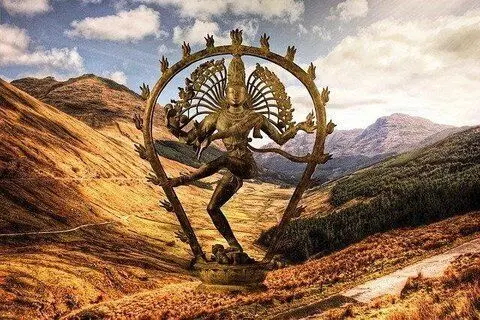
1. The circle of fire around the Nataraja statue represents the Big-Crunch (Scientists believe that at the end, the black hole will consume all the matter, and the universe will end in a circle of fire called Big-Crunch).
2. The dispersed hair of Lord Shiva represents the untied gravity that is sucking everything. In the sustainer form, his hair is tied together.
3. The Ganga, moon, and Sun in his dispersed hair represent that they are being sucked by gravity, and the black hole is consuming all the galaxies.
4. The snake is uncoiled, unlike the sustainer form. It represents that he is in an attacking position. The time and space are unwrapped and are about to end.
5. He has trampled Apasmara (the dwarf) with his right leg. It means the ignorant living beings are being crushed, but he is keeping his left leg in the air because he is not killing them permanently.
6. In his left upper hand, he holds a fire that symbolizes destruction. Normally, the damaru is attached to the trident, but in the Nataraja statue, it is in his upper right hand. It symbolizes the universe will be created again. This also indicates that he has taken the process of creation and destruction into his hands.
7. The same thing is represented by the other two hands. The lower left palm is in Gaja-Hasta (elephant trunk) mudra that represents liberation from the cycle of birth and rebirth, and the upper right palm is in Abhaya Mudra that represents reassurance that the universe would be created again.
Similarities between the Symbols Associated with Lord Shiva and a Black Hole:
Ganga – in Sanskrit, a galaxy is called Akasha Ganga.
Moon – as the Moon waxes and wanes, the universe also takes birth and dies.
Third eye – the center of a black hole.
Fire from the third eye – the beam of energy emitted by a black hole (Hawking radiation).
Snake – represents the wrap of space-time around a black hole.
Trident and Damaru – together represent creative and destructive power.
Nandi – constellation Taurus (bull).
Water/milk falling over Shiva lingam – represents the consumption of matter by a black hole.
Some stories in the Hindu scriptures can be correctly explained with these symbols.
Above, we mentioned that Lord Brahma is the universe. Daksha is mentioned as his son in the Puranas. Therefore, Daksha is symbolized as a star.
The Story of Birth of a Black Hole in the Atharva Veda:
The Atharvaveda Book 15 is dedicated to Vratya. It mentions the birth of Vratya in the 1st Paryaya.
“There was Vratya. He roused Prajapati to action. Prajapati beheld gold in Himself and engendered it. That became unique, that became distinguished, that became great, that became excellent, that became Brahman, that became Tapas, that became Truth: through that he (Vratya) was born. He grew, he became great, he became Mahadeva. He gained the lordship of the Gods. He became Ishana. He became Eka Vratya. He held a bow, even that Bow of Indra. His belly is dark-blue; his back is red (Nila Lohitam). With dark-blue, he envelops a detested rival, with red he pierces the man who hates him: so the knowers of Brahman say.”
The term Nila-Lohitam is used for Lord Shiva in the Linga Purana (2.19).
“He is of both Blue and Red color since both Pradhana and Purusha merge in him. Since the semen flows from him, he is known as Shukla.”
The same term is used in Shreemad Bhagavata Purana.
Some scholars do not agree that Vratya is Lord Shiva, but if you read the above paragraph, Vratya is mentioned as Mahadeva and Ishana. Those are the names of Lord Shiva. Also, the dark-blue belly denotes him being Lord Shiva.
Therefore, Vratya or Eka Vratya mentioned in the Atharvaveda symbolically represents Lord Shiva.
If we consider Daksha as a person, then we cannot explain how he engendered gold, but if we assume he is a star, then we can do so. The gold is formed inside a star through a process called nuclear fusion, and we know that a black hole is formed out of a star. Therefore, a black hole (Vratya) is a son of Daksha (star).
Why are Lord Vishnu and Lord Shiva Immortal but not Lord Brahma?
After a certain time, the universe dissolves into a black hole before it is created again. It means the universe dies for some time. That is why Lord Brahma is considered a mortal. Also sometimes Lord Brahma is depicted as an old man, which symbolizes the shrinking of the universe.
But the matter (Lord Vishnu) does not die. It is only concentrated at a single point (Lord Shiva). Hence, Lord Vishnu and Lord Shiva are considered immortal.
Why is a Shiva Lingam black mostly?
It is because of the color of a black hole.
Why is Lord Shiva called Mahakala?
Mahakala means beyond time/death. From the viewpoint of an observer outside the black hole, time stops in a black hole. The black holes are nearly indestructible. Theoretically, black holes may evaporate because of Hawking radiation, but it would take much longer than the entire age of the universe. If two black holes come closer to each other, they would merge to form a bigger black hole. Also, the primordial black hole is perpetual. Therefore, we can say that a black hole is beyond time/death.
Why is a vessel full of water/milk hung over a Shiva lingam?
The religious reason behind it is Lord Shiva is Abhishek Priya (one who likes an auspicious bath), and also, it cools and soothes his body from the heat produced due to the Halahala poison. Actually, it symbolizes the constant consumption of matter and energy by a black hole!
Is Hiranyagarbha the initial singularity?
Both Lord Vishnu (Shaligram stone) and Lord Shiva (Shiva lingam) are symbolized by the Hiranyagarbha. According to the Vedas, the universe originated from it, and according to modern science, the universe originated from the initial singularity.
We know that the Hiranyagarbha is golden in color. It is so because of its high temperature. According to the Big Bang theory, the universe at the beginning was very hot, small, and dense. Hot things look yellowish or golden in color. Therefore, we can say that the Hiranyagarbha is the initial singularity. That is why a Banalinga is worshiped and is considered more sacred.
Different shapes of a black hole:
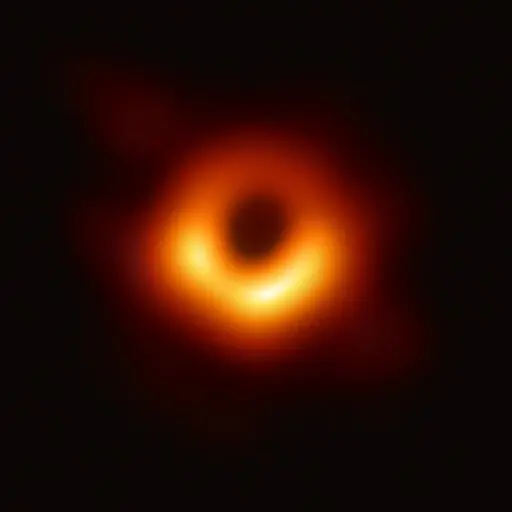
Image Credit: European Southern Observatory (licensed under CC-BY-SA 4.0)
It is a real picture of a black hole. We can see that it is surrounded by a yellow-red halo. It could mean its back is red as mentioned in the Atharvaveda. The picture is not clear. Therefore, we cannot definitely say whether it is black or dark blue.
We do not know what exactly the shape of a black hole is, but scientists have tried to figure out its shape.
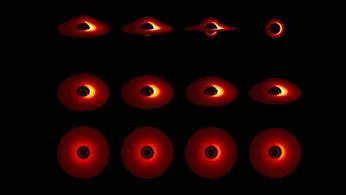
Image Credit: J. A. Marck and J. P. Luminet
The above photo is a visualization of a black hole by astrophysicists, J. A. Marck and J. P. Luminet. Some of these pictures resemble the shape of a Shiva lingam and also a Bana-lingam. If you consider only the uppermost portion in the figures, the shape of a swayambhu lingam also can be explained.
Therefore, the scientific meaning of the Shiva lingam is the initial singularity or Hiranyagarbha that is the creator, sustainer, and destroyer of the universe in the same way Lord Shiva is.
The Statue of Lord Shiva at CERN:
A few years ago scientists at CERN (“Conseil Européen pour la Recherche Nucléaire” or European Council for Nuclear Research) experimented to study sub-atomic particles and the conditions at the time of the Big Bang using the world’s largest and the most powerful particle accelerator LHC (Large Hadron Collider). There was a fear among people that a black hole could be formed during this experiment. The scientists at CERN did not deny the possibility of forming a black hole but stated that if it was formed, it would be very small and would not last long. According to a BBC report, they created a “mini Big Bang” by smashing together lead ions instead of protons.
In 2004, a 2-meter statue of Nataraja was unveiled at the CERN facility in Geneva. The reason given by CERN officials for this statue to be there was that it was a gift from India to celebrate its association with CERN, and Nataraja dance is a metaphor that was drawn between the cosmic dance of the Nataraja and the modern study of the ‘cosmic dance’ of subatomic particles.
But is it just a metaphor or is there something more in it?
References:
1. Brahma Gyan – The science behind Shiva by Ravikumar Kakde.
2. What Exactly Is A Shiva Linga by Rahul Dudhane.